Motorola Droid 3 Review - Third Time's a Charm
by Brian Klug on July 30, 2011 12:01 AM ESTThe Droid 3 also takes an incredible number of design nods from the Droid X2 (and its physically identical cousin, the Droid X). In fact, I’d almost consider the Droid 3 more of a Droid X2 with keyboard than an in-place update of the Droid 2. Almost every single side has some language from the X2’s design vocabulary.
Starting up at the very top is an incredibly similar power and lock button, which juts out squarely from the center. This is just like the Droid X2 button, and a huge departure from the Droid 2’s rounded, off-center design. The headphone jack is on the far side and hangs over the edge slightly. There’s also a small gap for prying the battery cover off the Droid 3, which also does double duty as a port for one of the Droid 3’s three microphones. The power button is easy to locate thanks to it jutting out by almost one mm, and has a communicative click. I always did find that the Droid 2’s rounded button made the device seem sleek, but made powering the thing on sometimes a challenge unless you always put your finger on the button immediately.
The part of the Droid 3 that I find most similar to the X2 is the left side, which includes a microUSB and microHDMI (type D) port on the bottom quarter. In-between the two is a small circle that looks like it was intended to accommodate a charging LED (which the Droid and Droid 2 both placed next to the microUSB port), instead it serves no such purpose and seems to be an afterthought. I should note that the Droid 3 box doesn’t include a microHDMI to HDMI cable, so you’ll wind up having to order one if you want to try HDMI mirroring, which the Droid 3 does support.
The bottom of the Droid 3 still includes the lip motif that the original Droid started, however the bottom part of the lip is no longer incorporated into top display piece which slides. Dead center and right where the display piece ends is the main microphone for voice. This bottom lip is coated with a glossy chrome material that shows fingerprints, as is the entire display lip. The gap between the display and bottom slider portion is just shy of a fingernail, and thankfully there’s very little flex with the device closed. We’ll go into more detail about the slider in a second.
The back of the Droid 3 is no longer a single metal piece, instead it’s one large snap-on plastic part. Getting the battery door off is almost as harrowing on the Droid 3 as it is on the Nokia N900 - jam a thumb in, then pry the entire affair off. No matter how many times I do this, it’s an unnerving experience.
Behind that door is the Motorola’s 5.7 Whr battery, which is larger in terms of capacity and different in size compared to the Droid 2 battery. It’s a different model number entirely, so you’re unfortunately out of luck if you’re a previous generation Droid owner with a small collection of batteries.
Next to it is the SIM card slot, which of course comes prepopulated a Verizon/Vodafone SIM you’ll need to activate if you want to roam abroad. The other option is of course to call, ask politely for (or buy) an unlock, but more on that later. Adjacent to the SIM slot is the microSD card slot, which comes without any preinstalled card. That’s right, there’s no microSD card provided with the Droid 3, instead I guess the logic is that 16 GB of internal storage supplants the need for potentially slower SD card based storage. You can always add one of your own, however. There are also four gold pogo pins also on the back of the device which make contact with the Droid 3’s optional inductive charging battery cover.
Below that is the speakerphone port, which has a slightly raised top side to prevent it from laying completely coplanar and being muffled by a table. There’s a nice mesh grille preventing grime from getting inside too far in the speakerphone port. Dead center is another microphone for noise cancellation and for use with some fancy DSP when recording video.
On the far right side is another interesting change, gone is the dual-detent camera button completely, just like the Droid X2. It’s a change I think will initially confuse existing Droid users, especially because of how notable the camera button was in previously differentiating the device. At the very top is the volume rocker, which is one solid piece of plastic that pivots. It’s nice and clicky, thankfully. There’s also a small gap up near the volume buttons which a corresponding bulge on the display slider mates into.
This is what keeps the Droid 3’s slider mechanism so firm when the phone is closed and in portrait mode. It doesn’t oreo effect at all or have much play at all. When being slid out, the same applies until the bottom part extends beyond the bulge.


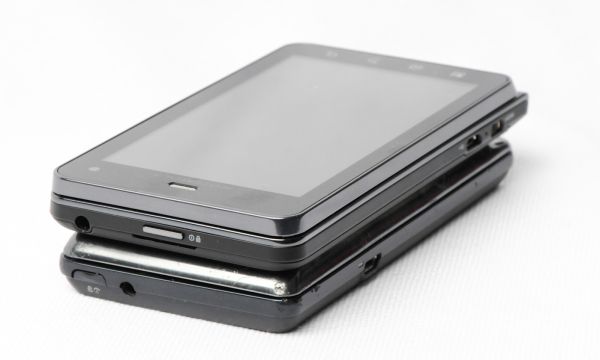
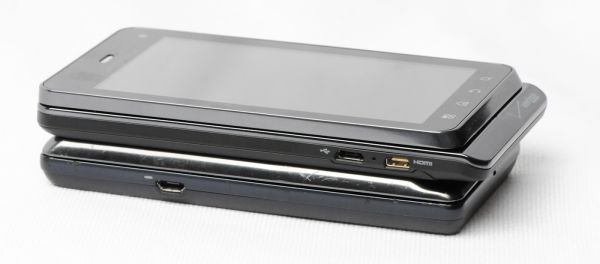
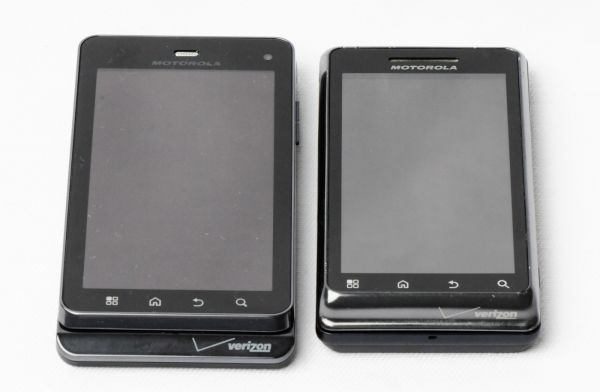

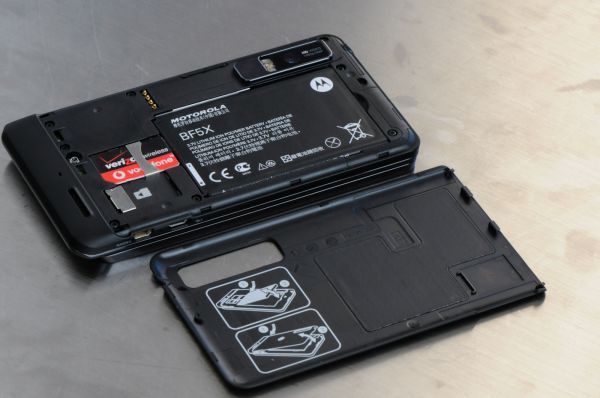

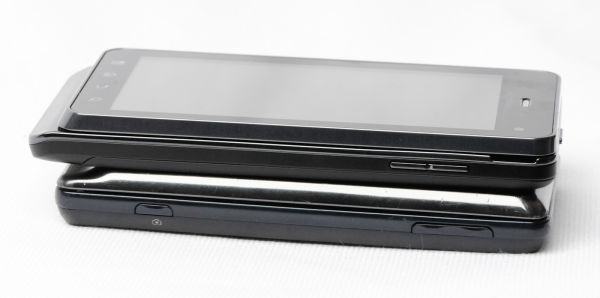
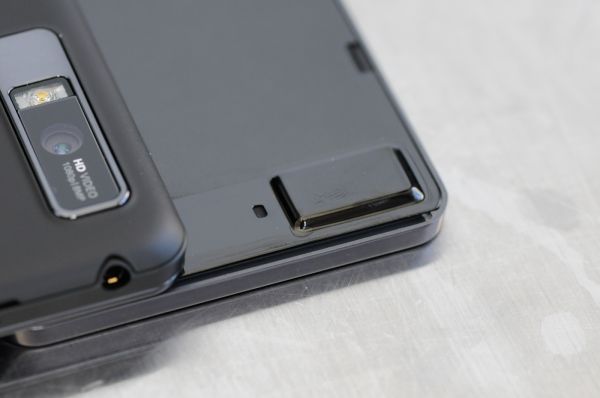








84 Comments
View All Comments
RoninX - Sunday, July 31, 2011 - link
I'm guessing that people who prefer a physical keyboard (like myself) would rather manually correct spelling errors than deal with <a href="http://damnyouautocorrect.com/">overly aggressive autocorrect algorithms</a>.I currently have a Droid 2 on a one-year contract that's eligible for an upgrade, and I'm strongly learning toward getting a Droid 3, due largely to the excellent keyboard.
I'll have to see the Pentile screen in-person before making a decision. I find it interesting that some people find the Pentile effect imperceptible, while others find it unbearable.
I'm also curious about the Samsung <a href="http://www.bgr.com/2011/07/29/atts-sleek-samsung-s... which looks like a dual-core Exynos slider. The keyboard doesn't look nearly as good as the Droid 3's, but the 3000+ score on Quadrant (similar to the SGS2) is intriguing...
RoninX - Sunday, July 31, 2011 - link
That should read, the Samsung http://www.bgr.com/2011/07/29/atts-sleek-samsung-s...">SCH-i927 dual-core Exynos slider.hackbod - Monday, August 1, 2011 - link
Auto-correcting input from a hard keyboard is actually very different than from a soft keyboard. A soft keyboard's auto correction is deeply tied to the key layout, and tables built to map specific tap positions on the keyboard to the possible letters that may be intended.The Android IME architecture *does* allow the IME to perform the same kinds of text processing operations on physical keyboard input as it does on touch input. However, in practice, a soft keyboard IME is designed around processing touch input, and you probably wouldn't want it to do the same processing of hard key input because the result would be poor.
jvchapman - Saturday, July 30, 2011 - link
No 4G = Useless.bjacobson - Saturday, July 30, 2011 - link
looks like the display is still sunken down under the gorilla glass like on the Droid1 and Droid2? The more I use others' phones (Samsung Galaxy, Iphone, etc) the more it bugs me on mine...significantly increases glare.bjacobson - Saturday, July 30, 2011 - link
The dragging down notifications bar animation, on all the OMAP based phones I played with, runs at 20-30 FPS best case.The Samsung Galaxy animation for it is much smoother for whatever reason.
This is the biggest beef I have with android phones; I play with my friend's Iphone 3gs and it's still smoother than the latest android hardware...
Mumrik - Saturday, July 30, 2011 - link
I really don't get why we have to have those sucky touch buttons under the screen when they could be proper physical buttons.Myrandex - Monday, August 1, 2011 - link
I agree. I miss call start and end buttons personally.Jason Cook
anandtech pirate - Saturday, July 30, 2011 - link
only 512mb of ram? I'm sure throwing in another 512mb wouldn't have added much to the cost. and I bet the performance boost would have been worth it.also..... whatever happened to the evo3D review?.... just wondering like a lot of other people
tipoo - Saturday, July 30, 2011 - link
Does anything indicate 512MB currently bottlenecks Android or its apps? We just moved away from 256MB not so long ago, after all.